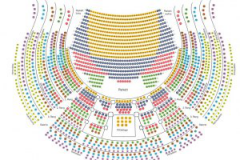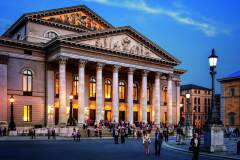Common Ground
Mo | Tu | We | Th | Fr | Sa | Su |
Ballet
Choreography Alexander Ekman, Hans van Manen, Johan Inger. Music Ludwig van Beethoven, Joseph Haydn, Franz Schubert (Arr. Andy Stein), Ibrahim Maalouf, Amos Ben-Tal. Spenser Theberge.
Three-part evening ("Cacti" 2016, "Grosse Fuge" 1971, "IMPASSE" 2020)
Duration est. 2 hours 10 minutes
Introductions take place one hour before the start of each performance (except on première evenings) in the 1st tier in the anteroom to the Königsloge.
Seating is limited, duration approx. 20 min.
Understanding common requirements is part of the nature of artistic work. From there on progress can be made and new work created. The three choreographers whose works form the Common Ground performance share a connection with the Nederlands Dans Theater (NDT) in The Hague. Along with a shared artistic conviction, in which humour also has its place, their choreographies are interwoven with connections filled with subtle content – and all of them have had world premieres at the NDT. The first two are inspired by music for string quartet. And the first and third pieces are each based in their own way on the concept of seduction.
In Alexander Ekman’s 2010 choreography, Cacti, the mechanisms of the cultural sector are taken to the test station. The question as to whether precisely in the area of art critique the woods sometimes perhaps can no longer be seen for the trees is posed with plenty of humour and the use of a speaking voice. In Cacti Ekman also turns the members of a string quartet into equal footing players on the stage alongside the dancers.
Hans van Manen’s 1971 piece Grosse Fuge is typical for its development period in which, also in the arts, the relationship between men and women was scrutinised and re-evaluated in the spirit of social modernization. Hans van Manen stages a virtuoso interplay of interpersonal rapprochement to the music of Ludwig van Beethoven.
For IMPASSE (2020) Johann Inger was guided by the idea of how we can find ourselves in a very specific spatial situation of hopelessness, and that also in the figurative sense as a society. How much we should stay true to ourselves in such a situation, how much we can be seduced by different life plans – Inger negotiates it all in poetic, and sometimes even bizarre images.
TOPIC
An initially seemingly innocent object such as a cactus can take on immense importance, if it is simply described verbosely enough. Alexander Ekman presents this on the stage with 16 cacti, also cacti in Latin, and with other bizarre means also scrutinises the conventions of the art sector and above all the speaking and writing about artistic products. There is much to laugh about in this piece, not just because of the theatrical situations in motion, but rather also because of the merging of text, music and movement.
With his Grosse Fuge (originally planned as the finale for his String Quartet Op.130, then published separately), Ludwig van Beethoven created a composition that defies categorisation. The piece left his contemporaries speechless – today it is marvelled for its originality. Hans van Manen combined Beethoven’s music, in Felix von Weingartner’s string orchestra version, with the preceding cavatina in Opus 130. In this musical space he choreographed a sequence for four women and four men, which at first is characterised by distance, but then increasingly more by proximity. The costume design still today questions applied gender images. The shirtless men at first wear skirts, however with well-visible belts. Later, as the couples begin to approach one another, they then also show some leg.
Impasse in French also means something like “dead end”. In a spatially corresponding stage situation Johan Inger explores how people react to the dawning of new facts, how they approach other people who have previously gone through life in an entirely different way to themselves. To energetic and multifaceted music from the pen of Ibrahim Maalouf and Amos Ben-Tal, Inger strings together episodes, which despite the basic hopelessness, are characterised by wit and above all by hope.
Program and cast
Conductor: Mikhail Agrest
Cacti
Choreographer: Alexander Ekman
Music: Franz SchubertJoseph HaydnLudwig van Beethoven
Lighting: Tom Visser
Grosse Fuge
Choreographer: Hans van Manen
Music: Ludwig van Beethoven
Stage Designer: Jean Paul Vroom
IMPASSE
Choreographer: Johan Inger
Music: Ibrahim MaaloufAmos Ben-Tal
Costume Designer: Bregje van Balen
Lighting: Tom Visser
Video: Annie Tådne
National Theatre Munich
The National Theatre Munich (German: Nationaltheater München) is an opera house in Max-Joseph-Platz in Munich, Germany. It is the home of the Bavarian State Opera and the Bayerisches Staatsballett(Bavarian State Ballet).
The Bavarian State Opera also performs in the Prinzregententheater, which opened in 1901 and, like the Bayreuth Festspielhaus, is built to Richard Wagner's specifications, and in the Cuvilliés Theatre at the Residenz, constructed in 1751–1753 and described by Thierry Beauvert as "a Rococo gem".
The Nationaltheater is very easy to get to both by car and by MVV public transportation.
By MVV public transportation
S-Bahn: S 1 - 8 Marienplatz
U-Bahn: U 3, 6 Marienplatz, U 3 - 6 Odeonsplatz
Bus: 52, 131 Marienplatz, 100 Odeonsplatz
Straßenbahn: 19 Nationaltheater
On the day of the performance, holders of regular tickets are entitled to use public transport provided by the Münchner Verkehrsverbund (MVV). This service starts at 3 pm respectively three hours before the performance commences and ends with the closing hour of the MVV.
By Car
Take the Altstadt-Ring to Maximilianstraße.
Parking garage Max-Joseph-Platz: open Monday to Sunday from 6:00 A.M. to 2:00 A.M.
You can take advantage of the special theatre parking fee of Euro 10,- from 6:00 P.M. to 8:00 A.M. by presenting your admission tickets.

 EN
EN DE
DE IT
IT FR
FR ES
ES RU
RU JP
JP RO
RO
 Seating plan
Seating plan 